Rafael Lozano-Hemmer : Vectorial Elevation, O’Connell Street, Dublin, April 22 – May 3, 2004
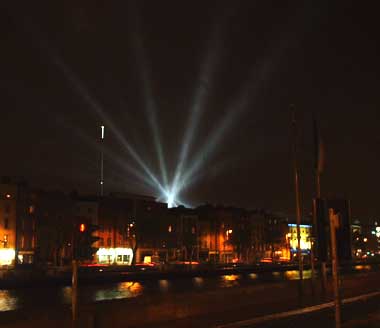 |
| Rafael Lozano-Hemmer, Vectorial Elevation, 2004, Light sculpture using robotic searchlights, photo credit: the author |
…My pieces do not exist unless someone dedicates some time to them… 1
To participate in Rafael Lozano-Hemmer’s nocturnal sky art, one had only to log onto alzado.net and follow straightforward instructions on the site to create a personal light sculpture. According to your preferences, the 22 robotic searchlights positioned along O’Connell Street would project your design into the heavens. Assuming the audience’s computer literacy, internet access, and universal possession of a personal e-mail address, Lozano-Hemmer’s piece was accessible to many, if not to all, and if you didn’t have the skill or the equipment to contribute to it, you certainly couldn’t escape seeing it (from a distance of up to 15 kilometres away).
…I am seduced by amplification, simulation, telematics and things that crash… 2
 |
| Rafael Lozano-Hemmer, Vectorial Elevation, 2004, detail of screen on O’Connell Street showing dedications and user interactions, photo credit: the author |
Since there was no prominent mention in the newspapers about the EU presidency meetings prioritising discussions on pressing environmental issues like sustainable energy usage, I decided to switch off the 154,000 watts of power used by the lights, and let the moon shine for a few seconds between projections in my light sculpture. Any artist will explain the equal importance given to negative and positive space in a sculpture, so it seemed darkness would be a natural element to control. But my design was either impossible to create, or too difficult to configure through the website interface; there seemed to be no option to switch off many of the lights. I opted then to make a sculpture involving four light beams, and waited to see when it would light up the sky. When my notifying e-mail arrived, I calculated whether I would be able to see the design in real time; I wasn’t, and settled instead to experience it virtually.
 |
 |
 |
 |
| Rafael Lozano-Hemmer, Vectorial Elevation, 2004, computer generated images showing Felicity Ford’s personal light-sculpture design; images held here |
I visited the webpage to see what my work looked like when it was shown in Dublin, and considered others doing the same thing. Dedications on the screen were personal, and the piece was an interesting subversion of the usually non-intimate functions of public art. Something vast, arguably intrusive, and monumental (though impermanent) was used to project the individual thoughts and feelings of people usually absent from such instances.
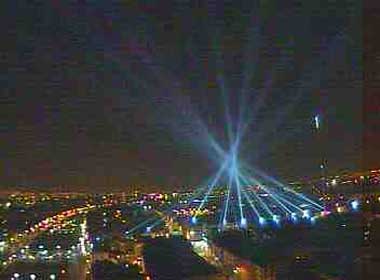 |
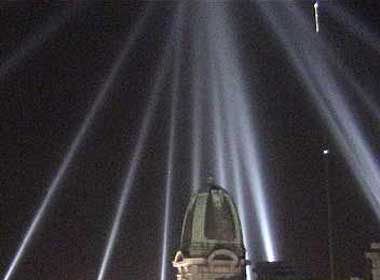 |
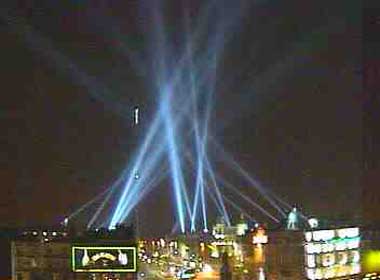 |
 |
| Rafael Lozano-Hemmer, Vectorial Elevation, 2004, web-camera images showing Felicity Ford’s personal light sculpture design; images held here |
But, walking up O’Connell street late on Monday 3 May, I couldn’t decide whether or not the piece had succeeded in its aim to subvert spectacle culture.
…The use of collimated searchlights in Albert Speer’s Nazi spectacles produced intimidating architectures of monologic power… 3
The beams of light moving above were exciting; they lent a sense of fantasy and film-noir to the night, weirdly illuminating Dublin’s deserted main thoroughfare as I wandered in the drizzle, feeling as if I were in Bladerunner, and questioning our relationships with technology and each other. But in another sense, the lights were lonely and redundant, roaming the skies aimlessly and bruising the bottom of rain clouds with their harsh trajectories. The screen flickered by itself like a broken neon light in a B-movie and there was no audience to witness Kieran telling Jean he had "a great time on friday night," or that "she was truly special." No doubt Jean experienced her dedication through a web-mail link like I did mine, and there was a distance between the experience of the event of creating a sculpture, and the documentation of it; a sense of remove from our own life, as when we feel we are in a film, spectators to our own lives, echoed often in the way we experience life in the society of the spectacle;
The spectacle is not a collection of images; rather, it is a social relationship between people that is mediated by images. 4
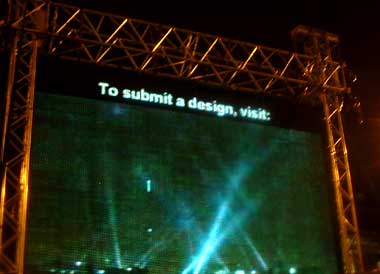 |
| Rafael Lozano-Hemmer, Vectorial Elevation, 2004, Screen on O’Connell Street showing dedications and user interactions, photo credit: the author |
…one of the roles of the artist is not so much to provide moralistic commentary but rather to create spaces for participation, where a plurality of positions may emerge… 5
One cannot help thinking that this "plurality of positions" mentioned by Lozano-Hemmer is a convenient ambivalence used to escape uncomfortable political dissent, which would have been revealed or inflamed by a less obfuscating artwork. As with the severe measures taken by the Gardaí to curtail the Dublin Grassroots Network’s ‘Bring the Noise’ protest, it was obvious that when the EU presidency get together, some types of expression are allowed, and other expressions are not. It’s fine to send personal love notes across the sky above O’Connell Street; perhaps not so fine to walk in the same place declaring certain opinions. Visual silence wasn’t an option in Lozano-Hemmer’s work. However, if one wanted to make noise in the form of another type of public intervention in public space (a planned march,) one could anticipate meeting heavily armed riot police and water cannons.
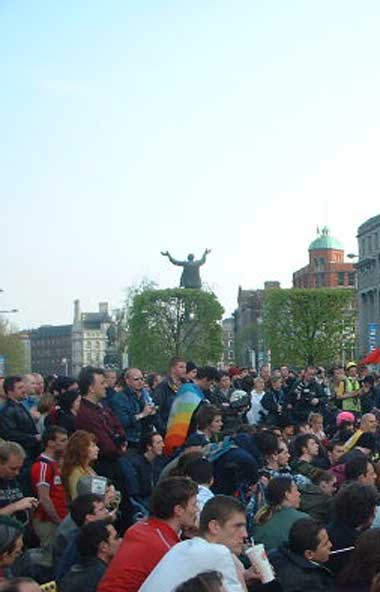 |
| Demonstrators outside the GPO on Saturday, May 1, to highlight the issue of eroded civil liberties, photo credit: the author |
There was a public meeting to demonstrate about the issue of eroded civil liberties in O’Connell Street on one of the days when the light sculpture was showing; I couldn’t help noting the irony of people gathering on O’Connell Street to protest the suppression of public political opinion beneath a sculpture whose main aim was arguably to give voice to the same public. Dissent appeared on the screen in the form of certain statements put up by individuals, but, experienced through the various mediums of screens, websites and so on, these were a dilute form of the vibrant physical presence of participating, physical bodies, gathered in real space and time to define their own interaction with public space, on their own terms. Lozano-Hemmer says he respects the work of artists "who have deployed deeply creative strategies to reveal and debunk the power narratives of certain public settings;" 6 but such debunking is perhaps unnecessary in locations where the primacy of certain political agendas is already blatantly clear: As bright, in fact, as the lights in Vectorial Elevation, and as difficult to oppose through either silence, darkness, or moonlight.
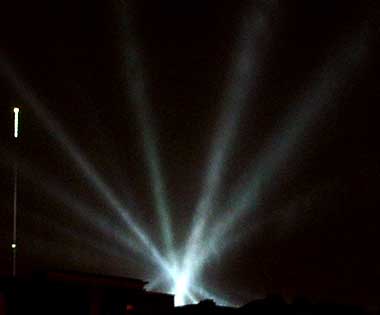 |
| Rafael Lozano-Hemmer, Vectorial Elevation, 2004, Light sculpture using robotic searchlights, photo credit: the author |
Felicity Ford is an artist and writer based at the moment in Killiney;she is currently involved with the installation of her sound-works in the end-of-year DLIADT graduation showcase, and is working with arts-and-theatre collective Spacecraft on their current production, Bleeding the System.
1. Rafael Lozano-Hemmer, Interview with Rafael Lozano-Hemmer for the Ars Electronica 2001 Catalog, Linz, 2001
2. Ibid.
3. Quoted from the history page of the official dublin elevation website: http://www4.alzado.net/edinformacion.html
4. Debord, Guy, "Separation Perfected," The Society of the Spectacle, http://www.cddc.vt.edu/sionline/si/tsotso01.html
5. Rafael Lozano-Hemmer, Interview with Rafael Lozano Hemmer for the Ars Electronica 2001 Catalog, Linz, 2001
6. Ibid.